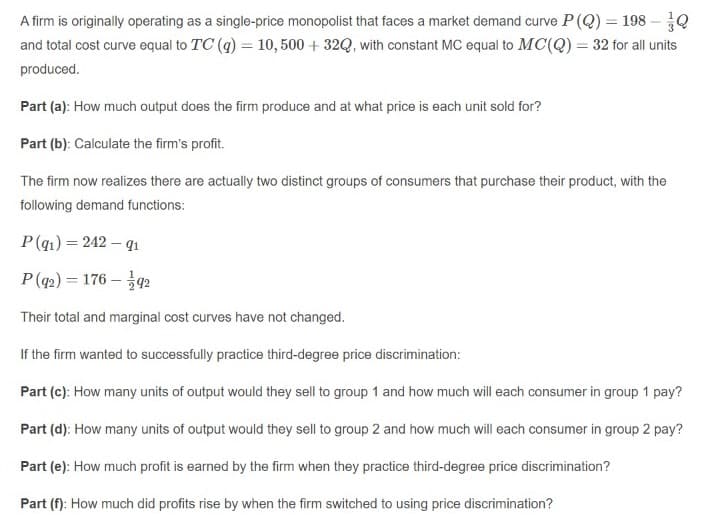A firm is originally operating as a single-price monopolist that faces a market demand curve P(Q) = 198 – and total cost curve equal to TC (q) = 10, 500 + 32Q, with constant MC equal to MC(Q) = 32 for all units produced. Part (a): How much output does the firm produce and at what price is each unit sold for? Part (b): Calculate the firm's profit. The firm now realizes there are actually two distinct groups of consumers that purchase their product, with the following demand functions: P(q1) = 242 – q1 P(q2) = 176 – 92 Their total and marginal cost curves have not changed. If the firm wanted to successfully practice third-degree price discrimination: Part (c): How many units of output would they sell to group 1 and how much will each consumer in group 1 pay?
A firm is originally operating as a single-price monopolist that faces a market demand curve P(Q) = 198 – and total cost curve equal to TC (q) = 10, 500 + 32Q, with constant MC equal to MC(Q) = 32 for all units produced. Part (a): How much output does the firm produce and at what price is each unit sold for? Part (b): Calculate the firm's profit. The firm now realizes there are actually two distinct groups of consumers that purchase their product, with the following demand functions: P(q1) = 242 – q1 P(q2) = 176 – 92 Their total and marginal cost curves have not changed. If the firm wanted to successfully practice third-degree price discrimination: Part (c): How many units of output would they sell to group 1 and how much will each consumer in group 1 pay?
Micro Economics For Today
10th Edition
ISBN:9781337613064
Author:Tucker, Irvin B.
Publisher:Tucker, Irvin B.
Chapter9: Monopoly
Section: Chapter Questions
Problem 19SQ
Related questions
Question

Transcribed Image Text:A firm is originally operating as a single-price monopolist that faces a market demand curve P(Q) = 198 –0
and total cost curve equal to TC (q) = 10, 500 + 32Q, with constant MC equal to MC(Q) = 32 for all units
produced.
Part (a): How much output does the firm produce and at what price is each unit sold for?
Part (b): Calculate the firm's profit.
The firm now realizes there are actually two distinct groups of consumers that purchase their product, with the
following demand functions:
P(q1) = 242 – qı
P(q2) = 176 – 92
Their total and marginal cost curves have not changed.
If the firm wanted to successfully practice third-degree price discrimination:
Part (c): How many units of output would they sell to group 1 and how much will each consumer in group 1 pay?
Part (d): How many units of output would they sell to group 2 and how much will each consumer in group 2 pay?
Part (e): How much profit is earned by the firm when they practice third-degree price discrimination?
Part (f): How much did profits rise by when the firm switched to using price discrimination?
Expert Solution
This question has been solved!
Explore an expertly crafted, step-by-step solution for a thorough understanding of key concepts.
Step by step
Solved in 2 steps

Knowledge Booster
Learn more about
Need a deep-dive on the concept behind this application? Look no further. Learn more about this topic, economics and related others by exploring similar questions and additional content below.Recommended textbooks for you








Microeconomics: Principles & Policy
Economics
ISBN:
9781337794992
Author:
William J. Baumol, Alan S. Blinder, John L. Solow
Publisher:
Cengage Learning
